Qualcomm's Quad-Core Snapdragon S4 (APQ8064/Adreno 320) Performance Preview
by Anand Lal Shimpi & Brian Klug on July 24, 2012 7:10 PM EST- Posted in
- Smartphones
- Snapdragon
- Qualcomm
- Mobile
- Tablets
- APQ8064
- SoCs
- S4
If you've been following our SoC related coverage, you'll probably have come across our coverage of Qualcomm's upcoming SoCs in their Mobile Development Platforms (MDPs). It's an interesting way to get both a feeling for the performance of a given platform before things are final, and to see how much OEMs affect the final performance.
Qualcomm flew us out to San Francisco to take a look at its newest part, APQ8064, which is quad core Krait v2 at up to 1.5 GHz with Qualcomm's new Adreno 320 GPU, and no baseband. This is a SoC destined primarily for tablets, although the combination of APQ8064 and MDM9615 will likely also be a common upcoming platform for the highest end phones.
At present, this is the same Krait CPU as what we've seen in MSM8960 in phones like the USA versions of the Galaxy S 3 and HTC One X. Later on, Krait v3 will emerge with higher IPC and shorter critical paths (and clocks up to 1.7 or 2 GHz) and a resulting 10-15% boost in performance. For now however we're looking at 1.5 GHz APQ8064 with a Krait v2 inside and Qualcomm's newest scalar GPU architecture with Adreno 320. We're going to talk more about Adreno 320 closer to devices shipping, when Qualcomm feels comfortable talking architecture.
Probably the single biggest notable change is the option in Adreno 320 to change from a TBR (Tile Based Renderer) to an immediate mode renderer on the fly. By default, the render mode is still TBR, however an API is exposed to allow applications to request immediate mode. In the future, some heuristics will be used to determine which mode is faster, including rendering some frames in immediate mode, some frames in TBR mode. Initial shipping devices with Adreno 320 will however just expose an API until the switching system is finalized. Update: Adreno is still a TBR not TBDR as stated earlier.
In terms of features, Adreno 320 adds OpenGL ES 3.0 (codename Halti) support, and GPGPU capabilities with OpenCL 1.2 and RenderScript. In terms of Windows APIs, Adreno 320 is Direct3D 11 feature level 9_3.
After a morning of sessions about benchmarks and how they reflect different areas of performance (which is another big discussion), we were given hands on time with the mobile development platform for APQ8064, the MDP/T APQ8064. MDP for Mobile Development Platform, T for Tablet. The MDP/T includes a 10.1" WXGA display (1366 x 720), 2 GB of LPDDR2 at 533 MHz (2x32 bits, PoP), 13 MP rear camera, 7 microphones, and all the usual ports and buttons. The tablet was running Android 4.0.4, and although the software is understandably not final, things were pretty stable. In addition, the MDP/T will be sold though Bsquare at some later date for $1299.
Performance
Before we get too far in our performance testing, a refresher of the usual caveats is a good idea. We were allowed unsupervised benchmarking time with the APQ8064 MDP/T, however this is still a reference platform. Final shipping devices may run at different speeds or deliver different performance based on their software configuration. While the MSM8960 MDP ended up performing very close to HTC's One X/S, anything can happen in the final implementation of an SoC.
We'll start our performance analysis with GLBenchmark, more specifically, some of the raw feature tests to see just how things have improved over the MSM8960:
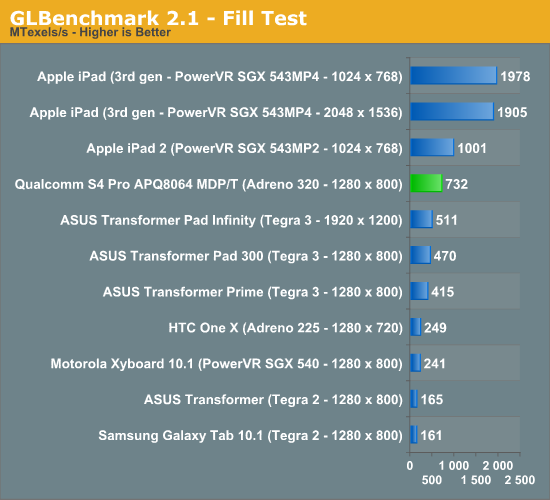
Raw fill rate almost tripled over the Adreno 225 in the HTC One X, and there's a healthy advantage over NVIDIA's Tegra 3 as well. Imagination's PowerVR SGX 543MP2 still manages a higher fill rate, and the MP4 in the new iPad can't be touched either.
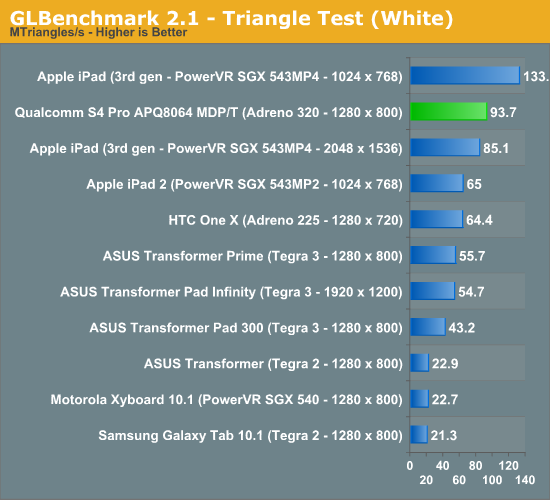
Raw polygon throughput is higher than everything aside from the 543MP4, an impressive step forward from the Adreno 225 but still not enough to outpace the high end ImgTec solution.
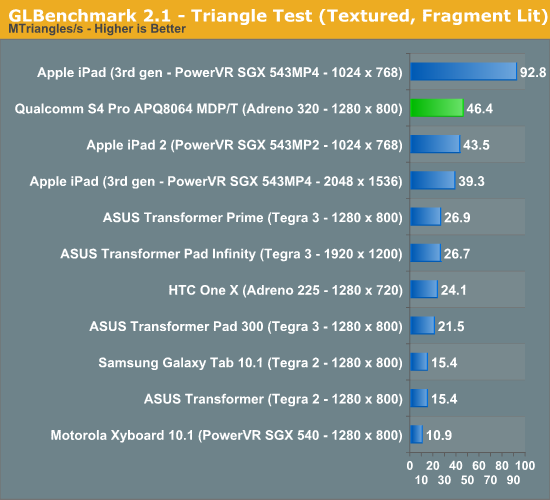
Here we see nearly 2x the triangle throughput of the Adreno 225, and better performance than the 543MP2. The MP4 continues to be a monster though.
These next two tests are rather meaningless as they're bound by vsync. Hopefully we'll see a newer version of GLBenchmark soon enough that will stress these devices more at native resolutions:
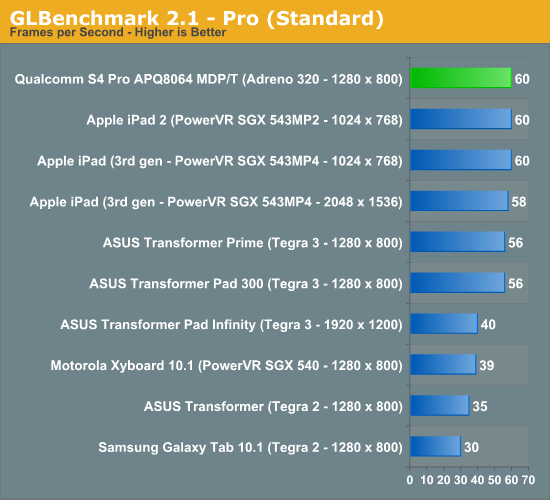
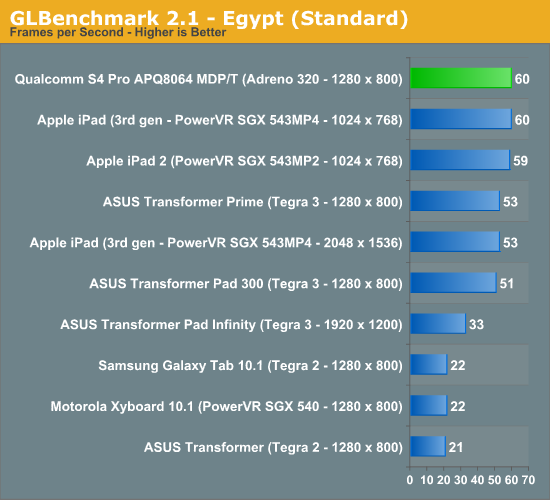
GLBenchmark gets around the default vsync requirement by rendering to an offscreen buffer at 720p, giving us a true apples-to-apples comparison of game-like performance among all of these SoCs. The quad-core S4 Pro with Adreno 320 does incredibly well:
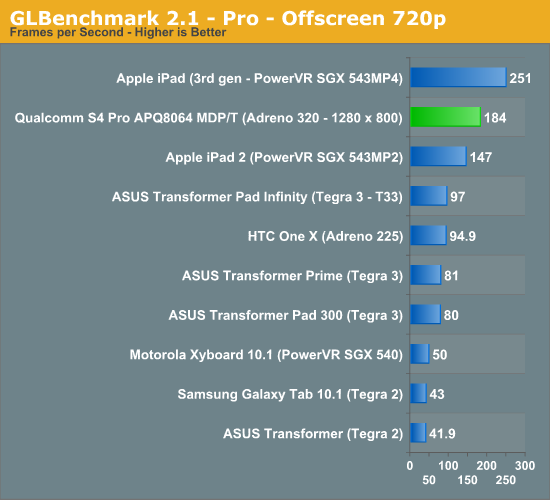
In the older Pro test frame rates are insanely high for most of the devices, indicating the age of the benchmark, but the Adreno 320's standings are very good - second to only the PowerVR SGX 543MP4. Compared to the Adreno 225, the 320 is almost twice as fast.
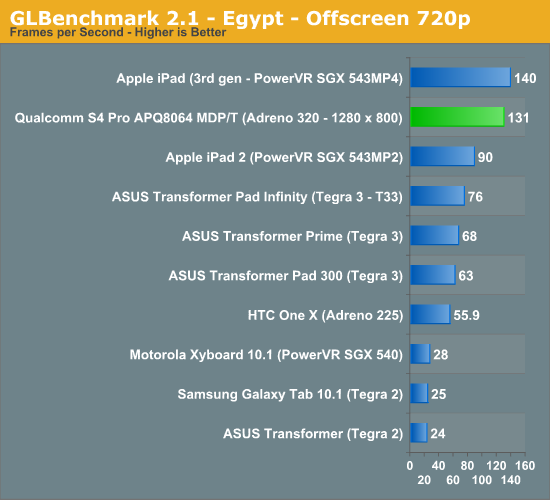
Egypt, the newer of the two "game" tests in GLBenchmark is a bit more stressful. Here the Adreno 320 gets extremely close to the SGX 543MP4 in the new iPad. Apple maintains a 6.8% performance advantage at 720p in this, a largely compute bound benchmark. Performance here is more than double that of the Adreno 225, and 72% faster than NVIDIA's fastest Tegra 3.
Overall Adreno 320 looks to be a good step forward in performance, although still a bit slower than the latest and greatest from Imagination Technologies. Compared to what everyone else is shipping in Android based tablets/smartphones however, Adreno 320 is easily the new king of the hill.
Qualcomm integrated four Krait v2 cores in the APQ8064 running at 1.5GHz, so CPU performance should range from very similar to significantly better than the dual-core Snapdragon S4 depending on the workload. Just as we've seen with Tegra 3, heavily threaded workloads will scale quite nicely while lightly threaded workloads will look mostly the same:

Sunspider performance is excellent on the MDP/T, actually delivering a better score than the Medfield based Lava Xolo X900 (1279.4ms). It's unclear how much of this performance increase over the dual-core S4 is due to the added cores vs. software optimizations to the MDP/T's browser.
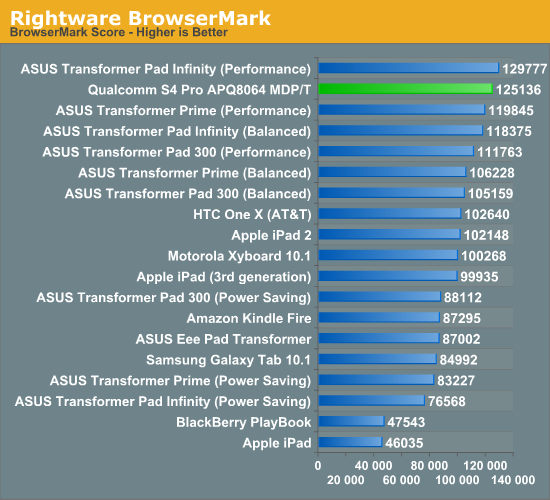
BrowserMark tells a much more conservative story, however the S4 Pro is still able to outpace the dual-core S4 based One X by 22%. Again we're doing a bit of apples-to-oranges here since the browser and remaining software stack between devices isn't perfectly identical.

Vellamo is Qualcomm's in-house developed web performance and scrolling benchmark, which soon will expand to include some more testing beyond JavaScript and scrolling performance (more on that later). For now, APQ8064 eeks out of the rest of the pack, but not by a huge margin. This again is using WebView which isn't heavily threaded.

BaseMark OS includes a heavily threaded benchmark that can hit all four cores in the MDP/T as well as in the Tegra 3 based devices. The overall score incoporates the SMP test but doesn't weight it too heavily. The end result is still good for the MDP/T; it's the fastest Android device we've tested here.
We ran the multithreaded Linpack Android test to confirm quad-core scaling and indeed we saw just that. While the HTC One X is good for a score of around 210 MFLOPS, the MDP/T with twice the cores hit 413 MFLOPS. We were able to get numbers as high as 514 MFLOPS, which is more a demonstration of the volatility of the test than anything else.
Overall the quad-core S4 Pro should deliver everything we love about the dual-core S4's performance, just with more cores. As individual cores can be power gated, there shouldn't be much of a power penalty unless you actually need the extra power. The extra cores should come in handy with heavy multitasking (something we may see even more of on Windows RT tablet/notebook hybrids) or with the rare heavily threaded application.


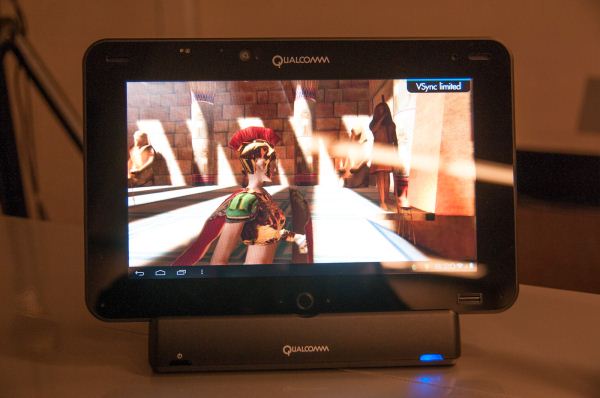






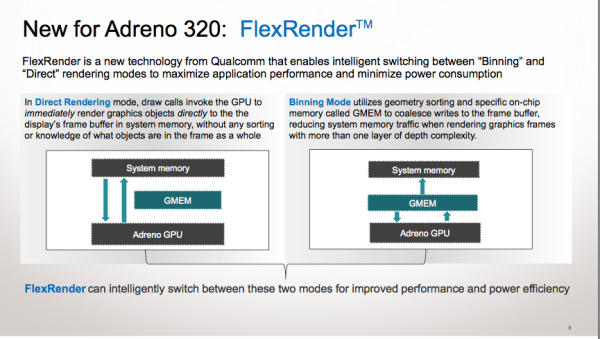














35 Comments
View All Comments
maglito - Tuesday, July 24, 2012 - link
It would be nice to see MX player with its FFD show based codec packs or/or VLC nightly performance.720p(modest bit rate), 1080p(decent bit rate) and full bit rate 1080 blu ray rips ala makemkv. Testing I've done on the nexus7 and galaxy nexus (same guts as nexus q) show this is a big area of needed improvement in next gen SoCs.
Consider testing off of the SD card and also playing back from a NAS over wifi.
ViRGE - Wednesday, July 25, 2012 - link
If I'm understanding this right, wouldn't this be bypassing all of the hardware acceleration features of the SoC? Why would you possibly want to do that? The whole point of having those features on the SoC is to take a CPU/power-hungry task and run it in fixed function hardware at a much lower power cost.Guspaz - Wednesday, July 25, 2012 - link
It's a decent test of CPU power, and not every codec is supported by hardware decode. Heck, it's not uncommon to come over h.264 video that uses some feature or level or profile not supported by the hardware decoder.Doing this sort of thing in software on a smartphone would be unpractical since it would cause a massive battery life problem, but it's not as big a deal on tablets, where you've got an enormous battery and the biggest power drain is the screen backlight. Qualcomm's test platform here is a tablet as well.
On the other hand, the OP could also be asking for benchmarks of the hardware decoding support. Not all hardware h.264 decoders are created equal.
maglito - Wednesday, July 25, 2012 - link
Correct. Especially with Qualcomm purchasing the HQV benchmark (Hollywood Quality Video) last year, I was very curious as to how well the new Adreno 320 decodes video.http://www.qualcomm.com/media/releases/2011/09/07/...
This type of testing seems long overdue.
maglito - Wednesday, July 25, 2012 - link
Both MX player and the VLC nightlys support hardware accelerated decoding to varying degrees. I'd be interested in either hardware or software results (obviously hardware should have an advantage if properly supported). In my testing on various current SoC 720p sometimes works without dropping too many frames (and very often the content will fail/crash too), but nothing can play back decent or full bitrate 1080p content at all. This is trying both software and hardware accelerated playback methods in various media players. With all new high end tablets being 1080p (technically 1200) and almost every other tablet being 720p (800) asking such a device to play at least 720p content off a NAS and not chocking shouldn't be too big a deal, but very often they fail. This is an area very overlooked by the press in reviewing these SoC/tablets and I'm hoping anandtech will lead the way in future reviews, as their coverage of such topics in the HTPC articles is excellent.Brian Klug - Thursday, July 26, 2012 - link
I'm actively looking for more tests - I've played with MX player before, but does it show any decode stats that we could present like number of dropped frames, load, etc? Without that I could only really report sort of a boolean pass/fail and subjective remark or two.-Brian
jleach1 - Monday, August 13, 2012 - link
Have you seen the tablet reviews over at Toms hardware? To test screen response they use some sort of high speed camera. That'd be something hard to acquire, but I don't think it's out of bounds given the quality and in depth-ness of long form, technical reviews here. I'd like to have all the information I require here, but the reality is, the combination of a few sites yields the best results. However, I receive 75% of my information here. A testament to the quality of the writers.Nonetheless, a simple 1-10 subjective quality test would be better than nothing. Probably in a few areas, since the software decode (ESPECIALLY in MX Player) has virtually identical quality regardless of the source file (extreme downgrades here)...pixelation could be shown in screenshots, color (cmpared to native playback), frame rate, and overall delight would be useful. We trust you guys, and only you guys, I might add, to make these type of subjective judgments, and report back until you guys become billionaires and make your own appsuite / benchmark for android.
lilmoe - Tuesday, July 24, 2012 - link
I'm confused. Why aren't you guys including Samsung's latest Exynos 4 Quad SoC in the benchmark tests? Exynos WILL be powering Samsung's next tablet, so I guess it's a viable comparison.It would be interesting to see how both the A5X and Snapdragon S4 (PowerVR and Adreno 320) perform against Exynos (ARM's Mali 400)... You never included "triangle tests" or "fill rates" in your "brief" preview of the Galaxy S3.... A full review is way over-due...
teiglin - Wednesday, July 25, 2012 - link
+1. I'd also like to see Exynos 4210 performance listed in with the rest of your benchmarks, as its Mali400 was far ahead of anything else in its generation aside from the A5's SGX 543MP2, to the point that it would also be at the very least competitive with tegra3. While my own use case of the Galaxy Tab 7.7 is admittedly niche, there are millions of people out here with international/AT&T GS2s, or international Galaxy Notes, who'd probably like to see if Adreno 320 provides enough of a GPU bump to be worthy of consideration.rd_nest - Wednesday, July 25, 2012 - link
I take AT as the most definitive tech site for reviews. But they seem to ignore most international Samsung products, or they are very late in reviewing them (case in point international SGS2).I can say one thing from experience that US-Galaxy series models just doesn't measure upto the international models. I am not referring to cores, but the overall smoothness or optimization of device. I thought the Exynos-based models are definitely smoother compared to Qualcomm-based models.
Samsung have actually made quite good improvement in driver front for Mali400. Check GLBenchmark 720 offscreen Egypt for SGS2 (http://www.anandtech.com/show/4686/samsung-galaxy-... last year and compare it today. It was 42 last year, now it's around 65 (same as Tegra3 or Adreno 225). About 50% increment in fps sounds great to me in a year because of driver optimization.
I have a feeling that Adreno 320 will have a tough time against Mali-T604. We will see, won't we??